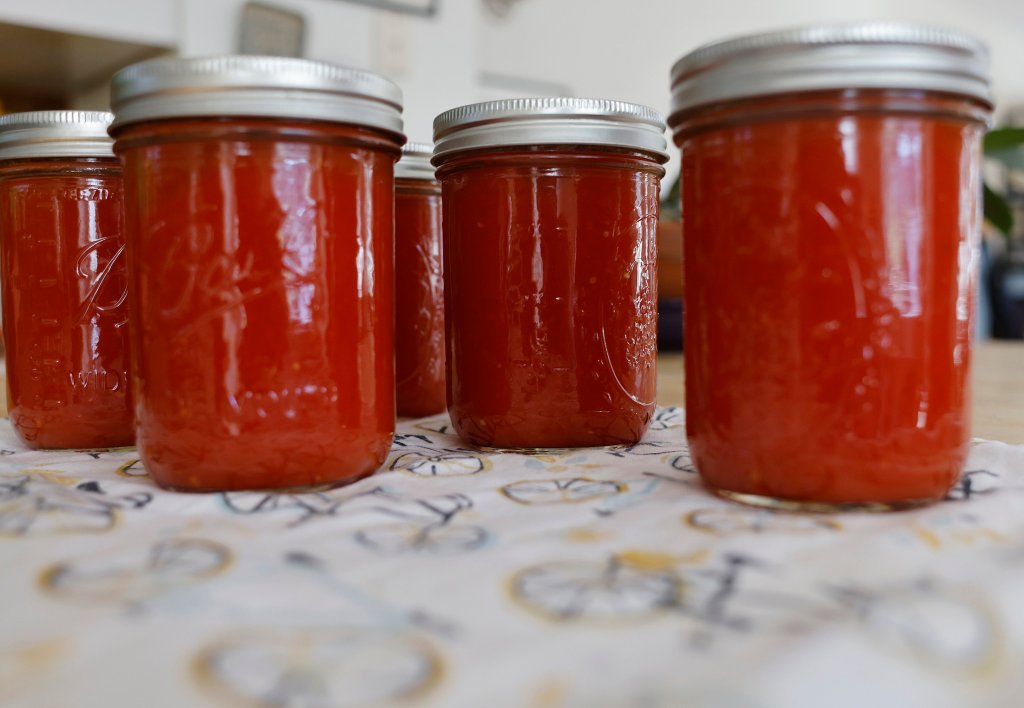 My first-ever attempt at passata, an Italian tomato puree. I made seven pint jars. (Derek Davis/Staff Photographer)
My first-ever attempt at passata, an Italian tomato puree. I made seven pint jars. (Derek Davis/Staff Photographer)
Late this summer when the local harvest was at its height, with both summer and fall vegetables coming in like gangbusters, I asked farmers at the Portland Farmers’ Market about their longest days.
“Harvest days,” Mike Farwell of Uncle’s Farmstand in Hollis answered without hesitation. “You can’t control the harvest. If the tomatoes are ready, or the beans or the okra, you can’t tell them, ‘Please hold on. I am busy with other things.’”
I remembered his comment, especially the part about tomatoes, after I bought a dauntingly gigantic box of them at the market the last weekend in September. For as long as I’ve been shopping at the Portland Farmers’ Market, I’ve eyed the boxes of tomato seconds that a few farmers sell at bewitching discounts as the season winds down. Some fall day, I’d annually promised myself, I’ll buy a box and make jars of home-canned tomatoes to cook with all winter long.
Last January, I put the plan – or more like aspiration – on my culinary bucket list, a list of items I’ve long wanted to make but frustratingly never have. I’m not getting any younger, so 2025 I pledged, would be the year I finally canned tomatoes (also stuffed grape leaves, attempted onigiri, made home-made pasta, and nine other items, one for each month of the year).
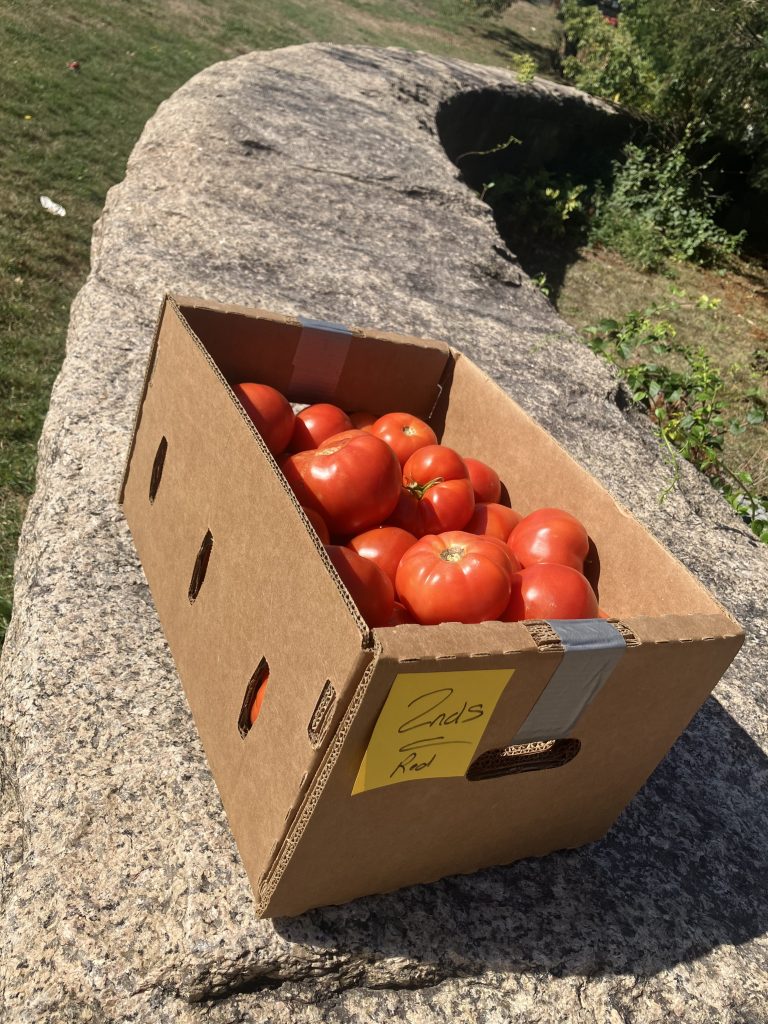 I stopped to rest at the entrance to the Portland Farmers’ Market in Deering Oaks Park. The box was heavy! (And is chivalry dead? No strapping young man offered to carry the box to my car.) (Photo by Peggy Grodinsky)
I stopped to rest at the entrance to the Portland Farmers’ Market in Deering Oaks Park. The box was heavy! (And is chivalry dead? No strapping young man offered to carry the box to my car.) (Photo by Peggy Grodinsky)
On Saturday, September 27, I handed over just $25 to the nice lady at the booth at the Snell Family Farm of Buxton, and I lugged a box home. She guesstimated its weight at 25 pounds (I think it was more). Bear in mind, tomatoes are selling for as much as $5.99 per pound at the farmers market, meaning at full price, I could have paid as much as $150.
I intended to can the tomatoes on Monday. Work got busy. Tuesday was no better. Nor Wednesday… you can see where this is going. Meanwhile, for much of the week Portland experienced one of its increasingly frequent fall heat waves; temperatures hit a record-breaking 86 degrees on Oct. 6. After a few days, I moved the box to the basement, the coolest part of the house.
The heat lingered, and the tomatoes relentlessly ripened.
“Please hold on. I am busy with other things,” I muttered in increasing panic in the direction of the box each morning as I emptied the basement dehumidifier.
THE BEST-LAID PLANS
By Oct. 6, the situation was dire. I’d reached the use-’em-or-lose-’em stage.
To safely can, vegetables and fruits must have a pH of 4.6 or below. Because tomatoes sit right at the border between high- and low-acid food, the U.S.D.A. recommends that home canners add bottled lemon juice or powdered citric acid to all tomato-based home-canned products. “Recommend” is a gentle understatement; get this wrong and you risk botulism. As tomatoes ripen, the danger increases, as they turn sweeter and less acidic. In short, I was now on Tomato Time, and I needed to get into the kitchen ASAP.
I’d planned to consult with or — better yet ― process the tomatoes under the direction of an experienced tomato canner. I’d planned to thumb through my canning and Italian cookbooks at leisure for guidance. I’d planned to carefully weigh my options: Whole tomatoes? Diced tomatoes? Tomato sauce? Tomato salsa? And I’d planned to watch as many internet videos as possible to alleviate my newbie anxieties.
In the end, my friend (and cookbook author) Mitchell Davis mentioned passata, which appealed to me for its ease. According to him, you roughly chop the entire tomato, skins, seeds, cores and all, add a little salt and cook them down. Use a food mill to strain out the skins and seeds, then return the puree to the stove to concentrate it. I’ve done pretty much the same thing for years to make and process applesauce so the technique felt comfortably familiar.
‘EDIBLE AND NICE’
I knew, kind of, that what I needed were San Marzano tomatoes or really any sort of plum tomatoes ― the sort that roughly resemble large red eggs. Plum tomatoes, also called paste or sauce tomatoes, are meatier and less juicy than beefsteak, which make them better-suited to canning. But no large boxes of discounted plum tomatoes materialized at the market, so I’d come home with beefsteak, labeled, a little vaguely, “2nds, Red.”
I took heart from the one video I actually watched before embarking on the process, a helpful UMaine Cooperative Extension webinar on “Preserving the Maine Harvest: Canning Tomatoes and Salsa.” In it, Food Systems Professional Kate McCarty recommends paste tomatoes, adding that the others “look kinda sad because they are more sensitive to heating, (but) they’ll still be edible and nice.”
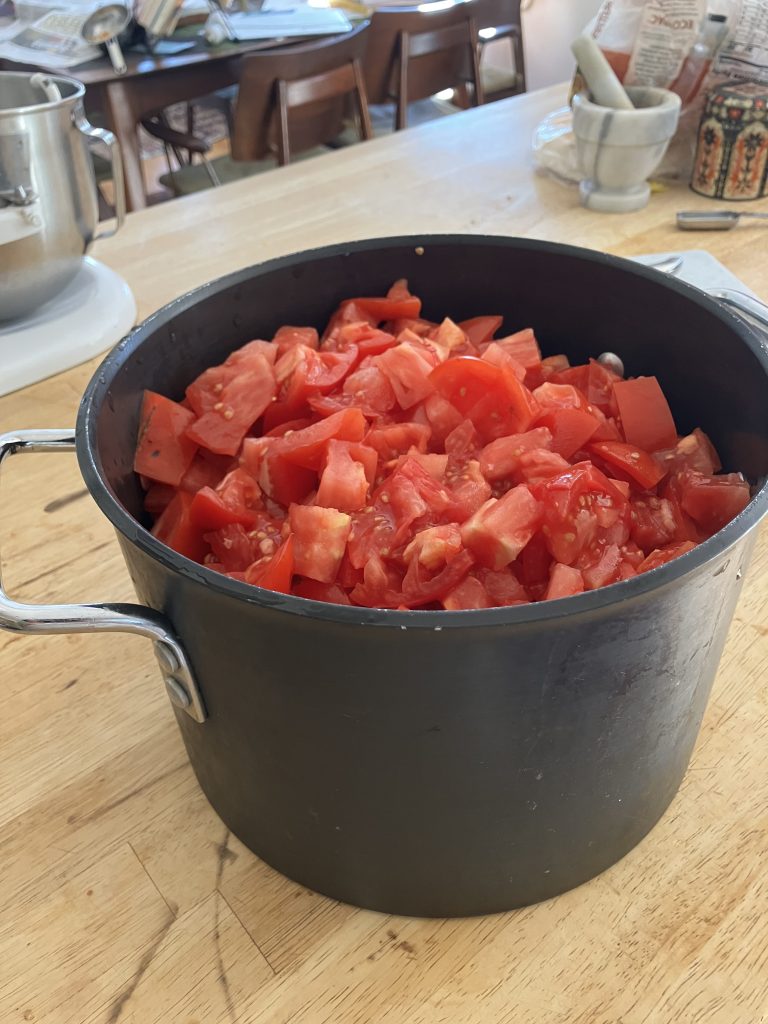 9 pounds of raw chopped tomatoes fill my largest pot. They’ll cook down to make passata. (Photo by Peggy Grodinsky)
9 pounds of raw chopped tomatoes fill my largest pot. They’ll cook down to make passata. (Photo by Peggy Grodinsky)
I cleaned and tidied the kitchen. I rinsed the tomatoes thoroughly. I washed and heated the mason jars and lids. I soaped up my hands, and I tied on a bandana to keep my hair out of the way. In canning, cleanliness is next to godliness.
As expected, the beefsteak tomatoes gave off A LOT of juice. I cooked 9 pounds of tomatoes down both for longer than I read I’d need to, about 45 minutes, and for less time than I probably should have. Is the passata I made too thin? Honestly, I don’t know. I’d read that it’s meant to be light, fresh and bright, and I feared if I concentrated it too much, it would lose those qualities. I’d also read that passata should have the consistency of a paste.
I was painting an elephant without ever having seen one.
WEDNESDAY MORNING QUARTERBACKING
Monte’s Fine Foods Assistant Kitchen Manager Nick Visconti to the rescue. I called him at the store in Portland too late to fix this batch, but there’s always next year.
Until he was 10, Visconti lived in Yonkers, New York, in the heart of a big Italian-American family, the sort of extended family of cousins, aunts and uncles that gathers weekly for Sunday suppers of baked ziti and an array of antipasti; the sort of multi-generational family with lush, productive, “super-ornate” gardens in a “big backyard that would be lined with statues, like, you know, the Virgin Mary,” he said.
The sort of family that annually assembled in late summer to process that year’s tomatoes into passata.
“We had the Viscontis, the Pocias, the Roccis,” he said. “Big fold-out tables covered in white tablecloths were lined up. Everybody would wear white, as well. I remember it being a big deal that you had to see the work that you did. It’s part of the fun to get messy.”
A candy burner was set up in a covered brick patio with a 64-gallon pot in which the tomatoes reduced all day long. “It had to be San Marzano tomatoes,” Visconti said. As the tomatoes simmered, there was a big feast with a lot of wine. His grandfather sang bits of Italian opera and urged family members to “Mangia!”
“It was all fun and games until my grandma Carolyn showed up and then it was very serious and everyone got quiet and paid attention,” Visconti said. “She would, as her seal of approval, put a single basil leaf on top of each jar as she was going by to check them, and then we would seal them up.”
No wonder Visconti ended up cooking for a living, and at Monte’s, which is well-known for its Roman-style pizza. Food is in his blood, he said. “It’s part of my family’s tradition, what we bond over.”
TOMATO GLUT
Though he says his memory may be unreliable, Visconti thinks his family canned between 150 and 200 jars of passata each year.
I canned seven pint jars; I could have filled two more but lacked space in my canner to process them, so I froze the extra passata. My canning session made a sizeable dent in the box of farmers market tomatoes, but an alarmingly big pile still remained. If two people and a ham equal eternity, a witticism often attributed to Dorothy Parker, what might she say about one person and 25 pounds of beefsteak tomatoes?
Over the next few days, staring down the “maturing” fruit, I followed up with a frenzy of cooking: Indian Tomato chutney; Moroccan eggplant and tomato salad (zaalouk); tomato-fennel soup; and with the last of the box (five squishy, seriously overripe specimens) tomato risotto. All excellent.
A single bruised, fermenting tomato went into the compost pile.
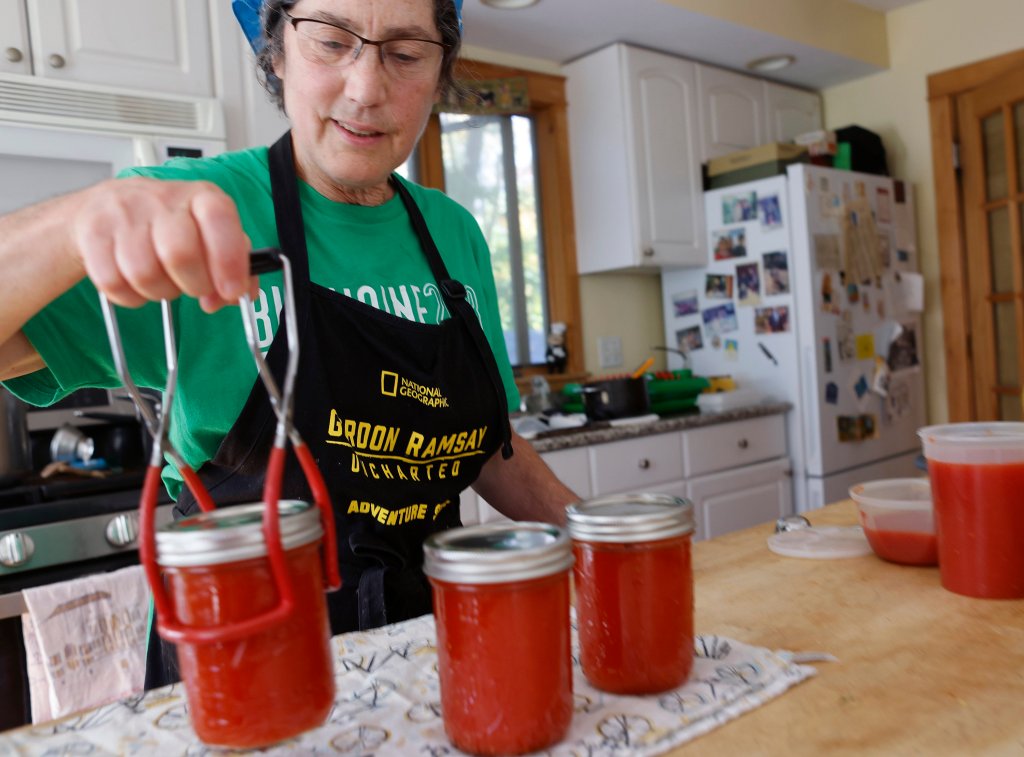 After the pints spent 35 minutes in a boiling water bath, followed by 5 more minutes in the water bath with the burner off, I removed them to the counter and waited for the lids to pop, an indication that the jar has sealed. (Derek Davis/Staff Photographer)
After the pints spent 35 minutes in a boiling water bath, followed by 5 more minutes in the water bath with the burner off, I removed them to the counter and waited for the lids to pop, an indication that the jar has sealed. (Derek Davis/Staff Photographer)
BETTER-THAN-TOMATO-CHUTNEY
The recipe comes from “American Masala” by Suvir Saran with Raquel Pelzel. The cookbook deserves to be better-known; I turn to it often. Find curry leaves locally at Masala Mahal in South Portland. The chutney is spicy, but eaten with a burgers, hash-browns, on grilled cheese sandwiches and more, blander items get a needed lively kick.
Yield: The cookbook gives a yield of 3 cups. In my experience, the recipe has yielded 5 to 7 half-pint jars.
1/4 cup canola oil
36 curry leaves, roughly torn
2 teaspoons brown mustard seeds
2 teaspoons cumin seeds
12 dried red chilies
1/2 teaspoon turmeric
3 ½ pounds tomatoes, cored and roughly chopped
1 (4.4 ounce) tube double-concentrated tomato paste or 1 (9 ounce) can tomato paste
2 tablespoons sugar
1 ½ to 2 teaspoons kosher salt
1/4 to 1/2 teaspoon cayenne pepper
1 teaspoon Sambhaar or rasam powder or 1/2 teaspoon curry powder
Bottled lemon juice, for canning in half-pint jars
Prepare the mason jars and other equipment, according to manufacturer’s instructions or follow guidance from UMaine Cooperative Extension.
Heat the oil with the curry leaves, mustard seeds, cumin seeds and chilies in a large pot or skillet over medium-high heat until the cumin is browned, about 2 minutes. Add the turmeric and cook until the chilies darken, 1 to 2 minutes longer.
Add the remaining ingredients and cook for 10 minutes, stirring occasionally and pressing the tomatoes against the sides of the pot to mash them if they are not breaking up on their own. Reduce the heat to medium and cook until the chutney is thick and jammy (if canning, cook until the mixture is very thick), stirring often, an additional 20 to 35 minutes.
Taste for seasonings, adding additional salt if need be, and transfer to container to refrigerate or to canning jars to process. If you are canning the chutney, put 1 ½ teaspoons bottled lemon juice in each of the half pint jars before you add the chutney and process.
TOMATO-FENNEL SOUP
This recipe is based on one from the New York Times, itself based on one from “The Silver Palate Cookbook.”
2 tablespoons unsalted butter
3 tablespoons olive oil
1 large fennel bulb, thinly sliced, fronds chopped and reserved
1 large onion, halved and thinly sliced
Salt to taste
4 garlic cloves, finely chopped
2 tablespoons tomato paste
1/2 to 1 teaspoon fennel seeds
3 to 4 tablespoons white wine
7 to 8 cups chopped, fresh tomatoes, peeled, seeds removed, “tomato water” saved
1 cup chicken stock
1 dried red chili pepper
Melt the butter and the oil in a large pot over medium heat. Add the fennel, onion and about ½ teaspoon salt. Stir. Reduce heat to medium-low. Partly cover and cook, stirring occasionally, until vegetables are very tender, about 20 minutes. Stir in the garlic and tomato paste; cook for a few minutes until you can smell the garlic and the tomato paste has turned a slightly deeper red.
Stir in the wine and cook until mostly evaporated, about 3 minutes. Pour in the chopped tomatoes, tomato water, stock and chili pepper. Bring to a simmer and cook gently, uncovered, for 30 minutes. Season with more salt to taste. Remove the dried chili, then purée the soup in batches.
Return the soup to the pot and gently reheat or reduce, if necessary. Ladle into bowls and garnish with the chopped fennel fronds.

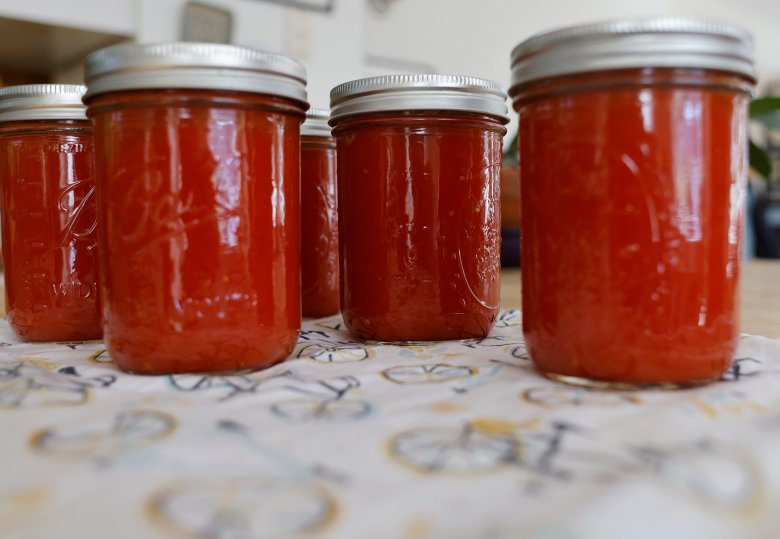
Dining and Cooking